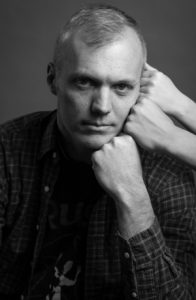 Patrick Madden was the winner of the 2016 AML Creative Non-Fiction Award, for his essay collection Sublime Physick (University of Nebraska Press). Today we present an interview with Madden conducted by Elizabeth Tidwell, a fellow BYU faculty member.
Patrick Madden was the winner of the 2016 AML Creative Non-Fiction Award, for his essay collection Sublime Physick (University of Nebraska Press). Today we present an interview with Madden conducted by Elizabeth Tidwell, a fellow BYU faculty member.
Patrick teaches creative nonfiction at Brigham Young University. His essays have appeared in the Iowa Review, Portland Magazine, Fourth Genre, Hotel Amerika, and other journals, as well as in the Best Creative Nonfiction and the Best American Spiritual Writing anthologies. His first essay collection, Quotidiana (Nebraska, 2010), also was given an AML award. He co-edited After Montaigne: Contemporary Essayists Cover the Essays (Georgia, 2015) with David Lazar and co-translated Eduardo Milán’s Selected Poems (Shearsman, 2012). He maintains an anthology of classical essays and essay resources at quotidiana.org.
As your second collection of essays, what was unique or new this go-round? Did you go about the process differently, mentally or otherwise? Take us into some of the behind-the-scenes elements ofSublime Physick.
This book is actually quite a lot like my first book from a big-picture point of view. They’re each collections of about a dozen essays that derive from my personal experience and meditate, sometimes humorously, always with research, on abstractions. They’re different in their specifics, though. Sublime Physick looks into repentance, loss, worry, empathy, middle-agedness, moments of time, mimicry, the ripple effect, unrecognized endings, points of reference, and originality (oh, boy, does it look into originality, for nearly 100 pages), plus a lot more (if you subdivide the essays, which you should; I do).
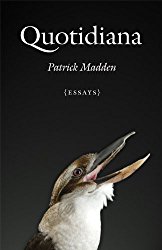 One element that carried over from your first collection, Quotidiana, is illustrations throughout the text, which is rather rare in books of essays. Can you talk about that choice? What effect do you hope illustrations have on readers’ experience of this collection?
One element that carried over from your first collection, Quotidiana, is illustrations throughout the text, which is rather rare in books of essays. Can you talk about that choice? What effect do you hope illustrations have on readers’ experience of this collection?
I hope pictures will become less rare in essay collections (and books in general) for the simple reason that images give readers something different and interesting to focus on and puzzle about, as both supplement and complement, and even as subversion to the text. I include images because 1) it’s easy to do nowadays (with computers for typesetting, instead of lead blocks) and 2) W. G. Sebald and Eduardo Galeano, two of my favorite writers, did it in some of their books, and I found their use of images to be deeply enriching. I hope that readers will pause a bit at the pictures in my books and think of them not only as illustrations showing what the words are already saying, but as another language that accompanies the text in order to enhance and challenge it. For instance, in each book, I’ve included images that give the lie to, that betray, what the text claims. This is one of the little silly games I play when I make a book. Maybe nobody notices, but I have fun with it anyway.
Another rare element of this collection compared to many contemporary essay collections is, of course, the long form essay. Tell us about this process. Was it as unruly as an 87-page essay might seem? What compelled you toward the length? Plenty of essayists agree that form is an organic pairing with content, but plenty of essayists also lean toward the merits of the brief essay. So, talk to us about form, and how this long-form essay came to be.
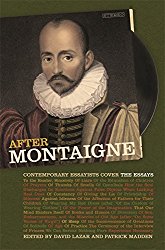 In the beginning, I was just writing an essay about originality, and I wanted to include several examples of musical plagiarism cases, such as George Harrison’s “My Sweet Lord” (the melody of which he subconsciously borrowed from the Chiffons’ “He’s So Fine”) and Coldplay’s “Viva La Vida,” which guitarist Joe Satriani said they stole from him. I wanted to get into the complexities of such claims and arguments, trying to find a more nuanced understanding of what we mean when we talk about “originality.” As I wrote, I kept finding more and more instances, and I branched out from popular twentieth-century music into other forms (painting and writing and inventing and others), then got to thinking about my own writing (asking myself whether I can claim any originality when I’ve been so directly and heavily influenced by so many other writers), and things just kept growing from there. I found that I had a lot to say, or to collate from other sources, so the essay became what it is (an exercise in transitions? in holding things together very loosely?). Also, at some point I realized that some of Montaigne’s longest essays, which I love, clock in at around 25,000–30,000 words, so I started aiming for that length. I console my guilty conscience by telling myself that people can just put down the book whenever they want. They don’t have to read the whole thing! (But some have told me that they truly like the essay, including the fact that it’s so long.)
In the beginning, I was just writing an essay about originality, and I wanted to include several examples of musical plagiarism cases, such as George Harrison’s “My Sweet Lord” (the melody of which he subconsciously borrowed from the Chiffons’ “He’s So Fine”) and Coldplay’s “Viva La Vida,” which guitarist Joe Satriani said they stole from him. I wanted to get into the complexities of such claims and arguments, trying to find a more nuanced understanding of what we mean when we talk about “originality.” As I wrote, I kept finding more and more instances, and I branched out from popular twentieth-century music into other forms (painting and writing and inventing and others), then got to thinking about my own writing (asking myself whether I can claim any originality when I’ve been so directly and heavily influenced by so many other writers), and things just kept growing from there. I found that I had a lot to say, or to collate from other sources, so the essay became what it is (an exercise in transitions? in holding things together very loosely?). Also, at some point I realized that some of Montaigne’s longest essays, which I love, clock in at around 25,000–30,000 words, so I started aiming for that length. I console my guilty conscience by telling myself that people can just put down the book whenever they want. They don’t have to read the whole thing! (But some have told me that they truly like the essay, including the fact that it’s so long.)
I’m interested in hearing what you have to say about how the essay informs a life. Clearly the inverse is true (life informs essays by lending experiences), but this collection is less interested in narrating a life and more interested in meditating on one. You mention how the universe essentially conspires with you when you’re “in an essay” by seemingly handing you essay material, but beyond that, you also do a lot of experimental investments of your own initiative, like the DNA test in “Spit” which resulted in an internal understanding (an essay) but also external manifestation of the essay: you found a relative and added a new person into your life. So, as essaying is a way of being, how has that manifested externally? Are there other examples beyond adding Kevin into your life?
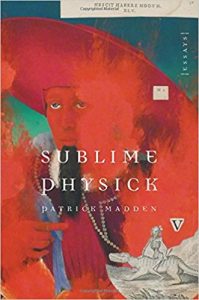 Thank you for noticing this. I want to be cautious about claiming too much, but I do believe, from my own experience, that reading and writing essays contributes to my happiness, and not just in direct, circular ways (because I like reading essays, reading essays makes me happy), though that’s true, too. Maybe for a Mormon audience I can make this parallel: obeying the Word of Wisdom brings direct, real-world benefits (better health), but it can also bring otherworldy benefits, too. I’m also cautious about confusing cause and effect or overstating correlations, but I… well, maybe God likes essays, too, and they provide a platform for his mischievous meddling in our lives? “Mischievous” is the wrong word. Maybe “playful”? My favorite example from the book comes at the end of “On Being Recognized,” which I thought I had finished, but then I was taking a plane home from Chicago and there, sitting right next to me, was Eddie Money, the musician. I wasn’t quite sure that it was Eddie Money at first, though I knew it was somebody “famous,” and little by little I gathered clues to figure it out. And then I decided that of all the famous people to sit next to, Eddie Money was the best, precisely because I had to puzzle out who he was, so that the essay moved away from me being recognized to him being recognized. Also, he was a very pleasant fellow, and now we send each other Christmas cards and he’s invited my family out to his Malibu beach house and… I’m just kidding. We talked for about a minute and then parted ways. But I think at least I didn’t bother him (much).
Thank you for noticing this. I want to be cautious about claiming too much, but I do believe, from my own experience, that reading and writing essays contributes to my happiness, and not just in direct, circular ways (because I like reading essays, reading essays makes me happy), though that’s true, too. Maybe for a Mormon audience I can make this parallel: obeying the Word of Wisdom brings direct, real-world benefits (better health), but it can also bring otherworldy benefits, too. I’m also cautious about confusing cause and effect or overstating correlations, but I… well, maybe God likes essays, too, and they provide a platform for his mischievous meddling in our lives? “Mischievous” is the wrong word. Maybe “playful”? My favorite example from the book comes at the end of “On Being Recognized,” which I thought I had finished, but then I was taking a plane home from Chicago and there, sitting right next to me, was Eddie Money, the musician. I wasn’t quite sure that it was Eddie Money at first, though I knew it was somebody “famous,” and little by little I gathered clues to figure it out. And then I decided that of all the famous people to sit next to, Eddie Money was the best, precisely because I had to puzzle out who he was, so that the essay moved away from me being recognized to him being recognized. Also, he was a very pleasant fellow, and now we send each other Christmas cards and he’s invited my family out to his Malibu beach house and… I’m just kidding. We talked for about a minute and then parted ways. But I think at least I didn’t bother him (much).
In your essay “In Media Vita” you mention the long-living Jeanne Calment seemed to have “the soul of an essayist”—which is to say, never getting bored. Do you find that this tendency, while clearly engaging and enlightening, can sometimes present a challenge at times? Clearly you’re not worried about FOMO (fear of missing out): “Miser’s Farthings” assures us that you agree with Charles Lamb that essayists exist doubly by “thinking on the events and living them.” But are there other struggles? For instance, do you ever feel too many pulls toward too many essays?
I certainly do feel too many ideas clamoring for attention, and I know that I’ll never get to write even a small fraction of them. I have many notebooks, and now phone notes, filled with ideas for essays. And I do get bored sometimes, and like many people nowadays, I sometimes go straight to my phone for relief, but I feel like I shouldn’t, like I should instead spend some time in my mind thinking interesting thoughts or challenging myself to seek and make connections or even, not often enough, talk with strangers, get to know people in a friendly way. And I probably do worry about missing out on things, though not nearly as much as my children do (they never want to go to bed) or my students do (some of them tremble before the wide-open possibilities of what to do with their lives). By the way, I’ve never heard that acronym “FOMO,” but it’s kind of catchy. I will say, too, that I sometimes really want to get out of essaying mode. I want to just do an activity without thinking metaconsciously about it, without wondering if it could make an essay. I especially enjoy playing sports for this reason. Whenever I’m playing volleyball or basketball or whatever it may be, I have to be focused wholly on the moment, so I can’t be ruminating meanwhile. This is refreshing, though I don’t think it’s ideal for all moments, nor would it be sustainable.
A major question that we keep coming back to as we read this collection is the idea of the self. Is the self knowable? Pin-down-able? Are essays as an avenue to understanding the self even possible? How can an essay enlighten our understanding of the self? I sometimes read essay collections and think:What a great representation of this unique person.We learn about essayists through their essays in many ways—voice, associations, form, quotations, etc. There’s just so much to the self, and it is immensely fluid. I’ve sometimes read collections and found that learning about the writer carries much of the value of the collection. So, through all these traditional avenues we learn about Pat Madden in Sublime Physick. But your collection does so much more—it addresses that idea again and again throughout the book, going deeper than just presenting the self, but questioning the very idea of the self, most ostensibly in “On Being Recognized.” But we also find this quote in “Fixity”: “The point of reference for the essayist is the self, and the essay’s humble attempt at understanding or at being can’t be but admired by any god I know.” I’m fascinated by this idea. Talk to us about how the essayist’s point of reference is the self when the nature of the self is fluid?
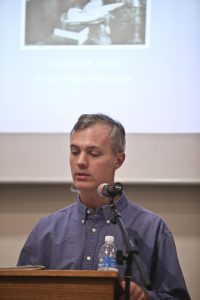 I’m glad you’re thinking these things. They’re what I think about a lot, too. I don’t think one can pin down a self (her own self or another’s), so then the question of knowing oneself hinges on how we understand knowing. On the one hand, I’d say, sure, of course, you can know yourself. We all know ourselves quite well. If there were a scale of knowing, we might find that we know ourselves better than we know anything else. Montaigne thought this, but he also thought something quite different (I don’t want to say “opposite”): “The more I frequent myself and know myself, the more my deformity astonishes me, and the less I understand myself.” And you’re right that through reading the essays of others, we gain some insight into them, and, we hope, into ourselves as well. But the insight is always partial and directed by the essayist, at least in part. Alexander Smith wrote, of Montaigne, that “if you wish to preserve your secret, wrap it up in frankness.” And while I’m not intentionally hiding anything deep and dark, I am portraying a side of myself that’s incomplete and a bit better than the Pat my wife knows or the Dad my children know. So while I’m not being misleadingly false, I am being selective. Yet this is really no different from how every one of us presents himself to others all the time (not just in writing, which is by definition a translation, but in “real life”).
I’m glad you’re thinking these things. They’re what I think about a lot, too. I don’t think one can pin down a self (her own self or another’s), so then the question of knowing oneself hinges on how we understand knowing. On the one hand, I’d say, sure, of course, you can know yourself. We all know ourselves quite well. If there were a scale of knowing, we might find that we know ourselves better than we know anything else. Montaigne thought this, but he also thought something quite different (I don’t want to say “opposite”): “The more I frequent myself and know myself, the more my deformity astonishes me, and the less I understand myself.” And you’re right that through reading the essays of others, we gain some insight into them, and, we hope, into ourselves as well. But the insight is always partial and directed by the essayist, at least in part. Alexander Smith wrote, of Montaigne, that “if you wish to preserve your secret, wrap it up in frankness.” And while I’m not intentionally hiding anything deep and dark, I am portraying a side of myself that’s incomplete and a bit better than the Pat my wife knows or the Dad my children know. So while I’m not being misleadingly false, I am being selective. Yet this is really no different from how every one of us presents himself to others all the time (not just in writing, which is by definition a translation, but in “real life”).
I’ll add that I’ve been fascinated by systems, especially those we can’t escape or maybe even perceive fully. The concept comes from my studies in physics, where, we learned, experimenters were always trying to eliminate external interference (for instance, air resistance when testing the acceleration of gravity). They were trying to establish closed systems that they could observe from the outside. And while physicists can get close enough to this detachment, humans can never really escape the many systems they move within, such as culture and family and even temporary groups like classes or concert audiences, and the system we’re most deeply and inescapably entrenched in is the self. Maybe the best we can do is imagine, and then resign ourselves to (and even celebrate) the fact that we are stuck.
What do you hope readers gain from reading Sublime Physick?
This is a difficult question, because I’ve been trying to shake off the notion that literature should be utilitarian (for instance, in the way Harriet Beecher Stowe’s Uncle Tom’s Cabin advanced the abolitionist cause). I’ve been talking quite a bit with my friend Mary Cappello about this, and I think I currently think that my books can simply provide some pleasure to thinking readers, because they (the books) represent an artistic distillation of curiosity and meandering connections, and thus they delight and surprise other curious meanderers, people who value a wonder-filled exploration of the world. In the case of Mormon readers, whom I’ll suppose are reading this interview, I’d hope that they might find a kind of heterodox reverence for creation and a contagious enthusiasm (from the Greek for “possessed by god”), maybe an ecumenical or a catholic perspective on ordinary holiness. I hope this might be pleasing to some people.
What projects are you currently working on? What can we plan on seeing from you in the future?
I’m writing shorter essays, trying to teach myself brevity and density, as well as essays in borrowed forms, such as one I initially wrote as a legitimate eBay auction (selling writer Michael Martone’s leftover water). My hope is to corral enough of these brief and borrowed pieces into a new collection of humorous essays. I’ll call it Disparates, which in English means, simply, “different things,” but in Spanish means “nonsense,” in the sense of “Oh, don’t be such a fool, Pat! Quit spouting that nonsense!” If all goes well, I’ll finish the book in just over a year, and in 2019 sometime the book will come out (from University of Nebraska Press, same as my other two books).
Can we have a pangram haiku for the road?
Ha! Lovely. We should explain that a pangram is a sentence that includes every letter of the alphabet, and a haiku…we know what a haiku is, at least what the English adoption of the Japanese form is: a three-line poem of 5, 7, and 5 syllables. I’ve combined the two minimalist forms in the “pangram haiku.” For the sake of this particular example, readers should know that when I was in high school, I lived for a couple of years in Baton Rouge. Thus:
“Mormon letters make
everything better,” quips the
wizened faux-Cajun
I think this is the first rhyming pangram haiku! You’ll see how the rhyme shoved all the difficult letters to the end of the poem, which created a really fun challenge.
Elizabeth Tidwell is an essayist who received an MFA in Creative Nonfiction from Brigham Young University in 2015. Her writing has appeared in Santa Clara Review, Brevity, and BYU Studies Quarterly. She currently teaches creative writing, composition, and yoga at BYU.
Thank you Elizabeth and Pat!

One thought